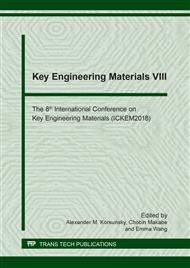p.26
p.32
p.36
p.43
p.50
p.57
p.63
p.68
p.74
Synthesis and Characterization of Transparent Conducting Film from Abaca Hybrid 7 Cellulose Acetate Blend and Polyaniline
Abstract:
This study dealt with the synthesis and characterization of thin transparent conducting films (TCF) from cellulose acetate (CA) blend and polyaniline (PANI). CA was produced from the pulp of abaca hybrid 7. CA-PANI films with different PANI loadings (0, 0.125, 0.25, 0.50, 1.0 and 2.0%) were produced using solvent casting method. Chemical transformations were analyzed using Fourier Transform Infrared (FTIR) spectroscopy. The conductivity was measured using the Four-Point Probe Test. Morphological characterization was done using Scanning Electron Microscopy (SEM). The transparency of the films was determined using UV-Vis Spectroscopy. FTIR spectra proved the embedment of PANI in the CA matrix. It was found that increasing the PANI loading increases the conductivity of the films but up to a certain limit. The highest average conductivity at 2.0264 x 10-5 S/m was observed in CA-PANI films with 0.50% PANI loading. SEM images revealed that conductivity is a function of PANI loading by forming networks. Further addition of PANI (1.0 and 2.0%) resulted to decreased conductivity due to agglomeration. Transparency, on the other hand, is negatively affected by PANI loading.
Info:
Periodical:
Pages:
50-56
Citation:
Online since:
August 2018
Keywords:
Price:
Сopyright:
© 2018 Trans Tech Publications Ltd. All Rights Reserved
Share:
Citation:


